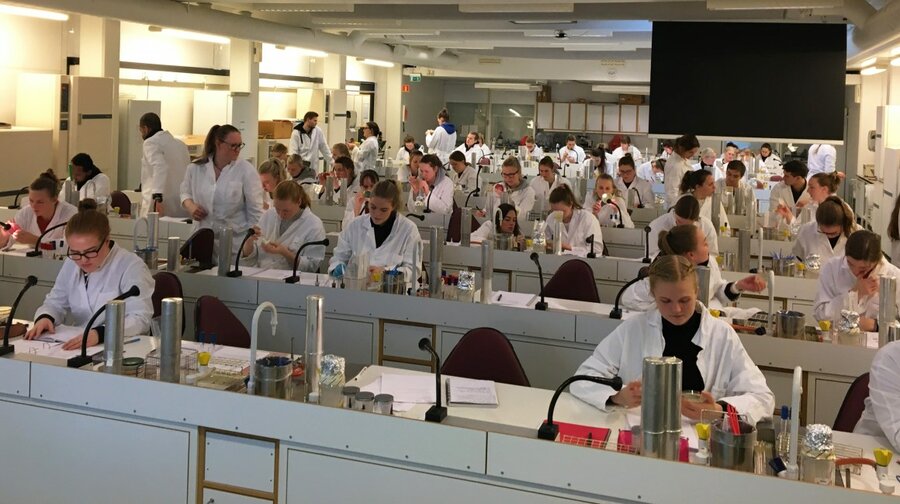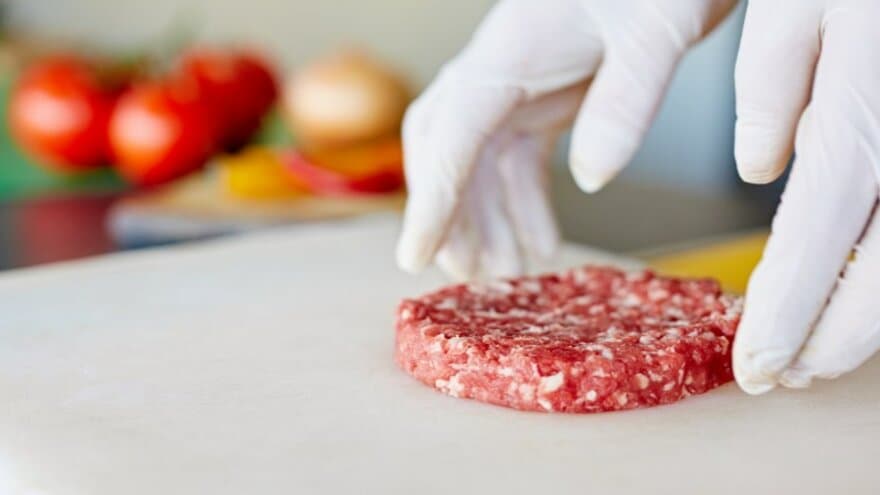Food safety is an important part of veterinary public health. We work with pathogenic bacteria that can be transmitted to humans through food and water.
About the Unit
Bacteria have an extraordinary ability to constantly adapt to changing environments and survive and grow in a wide range of habitats including foods. Some species cause illness in humans and spoilage of foods, and their presence in food products is, therefore, very problematic in many branches of the food industry.
The Food Safety Unit studies the mechanisms behind the ability of bacteria to persist in different environments and spread between human and animal hosts and colonize their intestines. Furthermore, we work on understanding the processes underlying development and spread of antibiotic resistance in food chains and in the environment.
Unit Manager
- Our major pathogens of focus are Bacillus, Listeria, Staphylococcus, pathogenic coli and Campylobacter.
- We have well-established quality assured food safety microbiological analyzes combined with professional expertise within food safety at a high scientific level.
- We have a well-established platform for generating spores of Bacillus and Clostridial species and for studying their resistance behavior and germination properties at a genetic and mechanistic level.
- We have methods for quantifying the levels and activity of toxins produced by different food-borne pathogenic bacteria.
- We have extensive knowledge about the development and spread of antibiotic resistant bacteria in various food chains and in the environment
- We use modern sequencing methods to characterize the genetic background and population structure of observed phenotypes
- We use genomic epidemiology and population structure of Campylobacter to trace origin of outbreaks and sporadic infections
The Food Safety lab works with research projects and routine tests in food microbiology. The laboratory is quality assured and accredited in accordance with NS-EN ISO/IEC 17025.
Contact: matmikrolab@nmbu.noWe teach veterinary students food microbiology and foodborne disease, how to prevent microbial contamination throughout the production chain of food and drinking water while ensuring high quality products.
There will always be risk associated with production of food and drinking water. It is therefore necessary for the food producers and food industry to work systematically with food safety to prevent microbial contamination at all stages of the food supply chain - from preharvest, through production, packaging, transport, retail and grocery until consumption.
Our goal is to teach veterinarians to protect people from infectious diseases born by foods and water. The veterinarian has a central role in the One Health framework, as it is the only health profession that is actively involved in all aspects of the food production chains: from farm to fork, stable to table and sea to eat. Our goal is that the future veterinarians gain an in depth understanding of food safety as a link between veterinary medicine and public health.
In addition we teach stand-alone PhD courses in One Health and Food Safety related topics on a regular interval. We supervise bachelors, masters and researchtrack students, in addition to PhD students. Currently, nine PhD-students are affiliated with the Section.

Food safety classPhoto: Marte Monshaugen
Ongoing research projects
The CLOBIO project will generate new knowledge on the composition and behavior of Clostridia and their spores in the value chains of Norwegian cheese and milk powder production in addition to explore their ability to deteriorate dairy products and potentially cause disease. More knowledge on the behavior of Clostridial spores will facilitate development of strategies for dealing with spore-related problems in the dairy industry.
NFR #295147 is a FFL/JA-financed project.
Contact: Marina Aspholm, project leader.
Noen bakteriesporer har pilus-lignende strukturer på sin ytre overflate som kalles appendikser. B. cereus sporene kan ha flere lange slike appendikser, men Some bacterial spores have pilus-like appendages on their outer surface. Bacillus cereus spores can carry abundant appendages that are up to 5 µm long and have an average width of 8 - 10 nm but their composition and genetic identity have remained unknown hitherto. In this project we have determine the appendage's genetic identity as well as their structural assembly. By using mutants lacking spore appendage genes we characterize the composition and architecture, genetic identity and the potential role of these poorly studied structures in colonization of mucosal tissues, in biofilm formation, and in attachment to inorganic surfaces.
Two PhD students for 3 years and one PostDoc for 2 years; financing source: NMBU.
Contact: Marina Aspholm, project leader.PLASTPATH is an interdisciplinary project combining technological and biological sciences to addressing the hitherto neglected, but potential, food-related hazard to human health represented by microbial communities associated with microplastics (MPs) (the plastisphere). Circulating MP particles provide favorable conditions for the establishment of microbial communities with high access to nutrients and high cell densities and can therefore act as ideal vectors for the accumulation and dissemination of pathogenic microorganisms. PLASTPATH will provide new knowledge on how association with MP particles influences the infectivity and survival of foodborne pathogens in the environment, and through the digestive system as these properties may change when the microbes are part of different plastisphere ecosystems. NFR #302996 is a BIONÆR-financed project.
Contact: Yngvild Wasteson, project leader.
The project investigates how operational, hygienic and climatic conditions influence the occurrence of human pathogenic bacteria in raw milk. Culturing techniques as well as comparative genomics is used to reveal transmission transmission routes and risk factors affecting presence of Enterohemmoragic E. coli (EHEC), Listeria monocytogenes and Campylobacter to in raw milk. Knowledge from the project will form the basis for assessing the growing demand for unpasteurized milk in the community. Veterinary public health and food safety are key areas of this project.
One PhD students for 3 years; financing source: NMBU.
Contact: Toril Lindbäck, project leader.
The project “Reinere Kyllinslakt” aims to find novel and efficient mitigation strategies to limit or reduce the bacterial load of broiler carcasses. The project is a collaborative effort between NMBU, the Norwegian Veterinary Institute, Animali, and Norsk Kylling. The project aims to investigate the bacterial load and risk factors for Campylobacter contamination through the entire chicken-chain, from farms, transport to slaughterhouses. The Food Safety Unit is tasked with identifying a method for rapid detection of the common foodborne pathogen Campylobacter spp. in chicken flocks.
Financing source: NRC #296327 and Norsk Kylling.
Contact: Ann-Katrin Llarena, project participant./om/ansatte/toril-lindbackThe overarching aim of this project is to improve the quality of postgraduate training through shared teaching at the UNZA School of Veterinary Medicine and Norwegian University of Life Sciences (NMBU) that is built on our mutual academic cooperation and student mobility. For UNZA, this is the next stage of excellence in postgraduate training and research in infectious diseases within a One Health paradigm; for NMBU this project will assist in improving the competence in the understanding and management of exotic infections in a more and more globalized world. The Food Safety Unit is involved in several projects and exchange programs with a focus on food safety and antimicrobial resistance.
Kontakt: Eystein Skjerve, project manager (Department of Production Animal Clinical Sciences)
From our unit: Ann-Katrin Llarena, Marina Aspholm, Yngvild Wasteson and Toril Lindbäck, project participants.
Read more on the project site.Hunt One Health is a project initiated to increase the knowledge on health and diseases in the human-animal interface. Exchange of pathogens such as virus, parasites and bacteria could cause diseases and the spread of antimicrobial resistance. To complement the data generated on the microorganisms present in the human fecal samples collected separately in the HUNT study, the samples collected in this study (Hunt One Health) all originate from fecal samples of companion- and production-animals (dog, sheep, pigs, horses and cows). To address the questions, the project aims to generate DNA-sequence data from these samples using shot-gun metagenomics to identify the microorganisms present in these samples/metagenomes, the functional potential and the resistome composition and other potential microbial genes of interest.
Contact: Eystein Skjerve (Department of Production Animal Clinical Sciences)
Involved from our unit: Ann-Katrin Llarena and Yngvild Wasteson, project participants.
Read more on the project siteThe NoResist project seeks to obtain knowledge on persistence and spread of antimicrobial resistance in the Norwegian food production chain which can be used to prevent, reduce or inhibit such resistance. The prime focus of the project is the poultry production chain, which currently is associated with the most serious challenges of antimicrobial resistant bacteria, i.e. extended spectrum betalactamase (ESBL) producing bacteria and quinolone resistant bacteria. These antimicrobials are defined by WHO to be among the critically important antimicrobial agents to be reserved for treatment of severe infections in humans.
The project is led by the Norwegian Veterinary Institute, and our group is responsible for workpackage 2) Identify risk factors of development and spread of antimicrobial resistance.
Research project funded by BIONÆR.
Contact person at NMBU: Yngvild Wasteson.Staphylococci are among the most recognized udder pathogens, and Staphylococcus aureus is considered one of the major pathogens causing clinical mastitis. Additionally, non‑aureus staphylococci are the most frequently isolated bacteria causing subclinical mastitis. Most antimicrobial treatments in dairy production concerns the control of udder infections, and this use of antimicrobials is regarded as an important driver for the selection of resistant staphylococci, of which methicillin-resistant S. aureus (MRSA) has gained most attention. However, methicillin resistance also occurs in several species of the non‑aureus staphylococci group. Resistant animal staphylococci are of public health concern as they can infect humans or become a part of the human microbiota, or they can transfer their resistance genes to human staphylococci strains.
This project is a collaborative project between the Veterinary Faculty and KBM at NMBU, and it has been part of a Belgium/French/Norwegian ANIHWA-project.
Contact: Yngvild Wasteson
